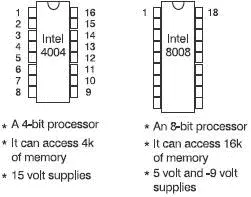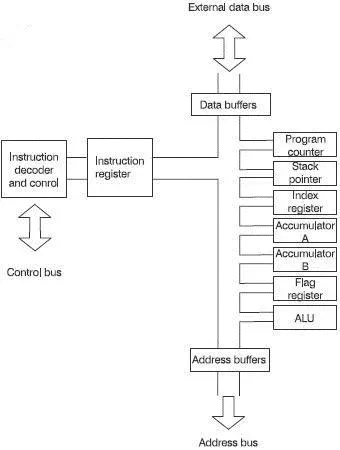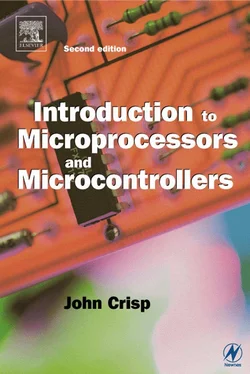John Crisp - Introduction to Microprocessors and Microcontrollers
Здесь есть возможность читать онлайн «John Crisp - Introduction to Microprocessors and Microcontrollers» весь текст электронной книги совершенно бесплатно (целиком полную версию без сокращений). В некоторых случаях можно слушать аудио, скачать через торрент в формате fb2 и присутствует краткое содержание. Год выпуска: 2004, ISBN: 2004, Издательство: Elsevier, Жанр: Компьютерное железо, на английском языке. Описание произведения, (предисловие) а так же отзывы посетителей доступны на портале библиотеки ЛибКат.
- Название:Introduction to Microprocessors and Microcontrollers
- Автор:
- Издательство:Elsevier
- Жанр:
- Год:2004
- ISBN:0-7506-5989-0
- Рейтинг книги:3 / 5. Голосов: 1
-
Избранное:Добавить в избранное
- Отзывы:
-
Ваша оценка:
- 60
- 1
- 2
- 3
- 4
- 5
Introduction to Microprocessors and Microcontrollers: краткое содержание, описание и аннотация
Предлагаем к чтению аннотацию, описание, краткое содержание или предисловие (зависит от того, что написал сам автор книги «Introduction to Microprocessors and Microcontrollers»). Если вы не нашли необходимую информацию о книге — напишите в комментариях, мы постараемся отыскать её.
Introduction to Microprocessors and Microcontrollers — читать онлайн бесплатно полную книгу (весь текст) целиком
Ниже представлен текст книги, разбитый по страницам. Система сохранения места последней прочитанной страницы, позволяет с удобством читать онлайн бесплатно книгу «Introduction to Microprocessors and Microcontrollers», без необходимости каждый раз заново искать на чём Вы остановились. Поставьте закладку, и сможете в любой момент перейти на страницу, на которой закончили чтение.
Интервал:
Закладка:
RISC versus CISC
Both RISC and CISC microprocessors employ all the go-faster techniques such as pipelining, superscalar structures and caches. A superscalar architecture is when there are two ALUs that share the processing like having two microprocessors. So, what are the real differences?
By analysing the code actually produced by compilers, we find that a small number of different instructions account for a very large proportion of the object code produced. Most popular are the instructions that deal with data being moved around.
At this point a curious switch of design occurred. You will remember that the ‘normal’ or CISC microprocessor included a microprogram in its instruction decoder or control unit. This microprogram was responsible for the internal steps necessary to carry out the instructions in the instruction code. So the microprocessor that we have been praising for its use of hardware to gain speed, is actually being run internally by software.
The RISC approach was to reduce the number of instructions available but keep them simple and do them fast. The number of instructions were reduced to under a hundred. Since instruction codes can be easily enhanced by adding some extras to the microprogram it was tempting to do it. No pruning of previous instruction was possible owing to the need to maintain compatibility with previous versions.
Following the cries of ‘hardware is faster than software’ it seemed a logical step to do away with the microprogram and replace it with hardware that could carry out the simple steps necessary. This hardware was made more simple by keeping all the instructions the same length so that pipelining was easier to organize. The only disadvantage of these constant length instructions is that they all have to be the same length as the longest and so the total program length will be increased.
CISC kept shoveling bucketfuls of data backwards and forwards between the microprocessor and the external memory using many different types of instruction. RISC designs just had a simple load and store instruction and everything else is done internally using a large number of registers to replace the external memory.
By the use of hardware for handling instructions and internal moves between registers, all instructions could be reduced to a single clock cycle, which gave a significant increase in speed. Generally, the Pentium Pro has managed to match this speed by its extensive use of pipelining.
As time goes by, there is an increasing tendency for the RISC/CISC difference to decrease. Modern RISC microprocessors like the PowerPC970 have an increasing number of instructions even though they do tend to be simple and fast and the more traditional CISC approach in the Pentium 4 is also employing simple yet extremely fast instructions.
As we know, our starting point was the Intel 4004 in 1972, very quickly followed by the 8-bit 8008 processor. These are shown in Figure 11.3. Notice that, even within a company, there was no agreement about the operating voltages.

Figure 11.3 The first 4-and 8-bit microprocessors
It also started the trend for numbering, rather than naming, a microprocessor. This made good sense since each basic design generated a series of variations, different speeds, modified instruction sets etc. The numbers can give a clue as to some of the basic characteristics and the hierarchy. Sometimes an X is used to signify a family of devices like the 80X86, so by giving different values to the X, we include the 80286, 80386 etc. The tendency now is to use a name and a number. This was due more to a legal problem owing to the difficulties of ‘owning’ a number. This was highlighted after Intel produced the 80286 followed by the 80386 and 80486, which gave its competitors rather advanced warning of the name of the next one. Intel couldn’t copyright the number 80586 otherwise mathematicians would fear prosecution if any calculation resulted in this number. They tried to call it the P5, claiming world rights over the letter P. Finally they went for ‘Pentium’. Apart from the fun of watching it all going on, the main beneficiaries, as usual, were the corporate lawyers (for whom we all pay, of course).
Intel versus Motorola
In December 1973, Intel introduced the 8080A. This was a very popular processor that had a 16-bit address bus so it can address up to 64 kbytes of memory or, as the adverts said at the time, ‘a MASSIVE 64k of memory’. The power supplies changed again, this time to +5 V, +12 V and –5 V. The number of instructions increased again and the number of pins increased to 40. Internally, there was the normal accumulator and eight general-purpose registers. This, then, became the standard package size for future 8-bit microprocessors as shown in Figure 11.4.

Figure 11.4 A standard size for 8-bit microprocessors
At about the same time, Motorola introduced a rival in the form of the MC6800. Like the Intel 8080A, this one was an 8-bit microprocessor with 16 address pins. At this point, the similarities ended. It was not compatible with the 8080A and so fought toe to toe in the market place, and came second!
The power supplies were simplified, now requiring only a single +5 V supply. A block diagram of the MC6800 is shown in Figure 11.5. We can see that it was unusual in not having any general purpose registers but it did have two accumulators. The approach here was to use an external memory location for the temporary storage of information that all previous microprocessors would have put into an internal register. The remainder of the microprocessor is quite familiar from our look at the Z80 in Chapter 8. The 6800 performed slightly faster than the 8080 on average, but not enough to break the hold of Intel in the marketplace.

Figure 11.5 MC6800 Motorola’s answer to the Intel 8080A
The final 8-bit microprocessors
At this time, Intel was working on the design of a replacement for the 8080A. It was a response to the criticisms of the 8080A: Why does it need three different power supplies when the 6800 only need one? And why only one interrupt pin when the 6800 has two?
At this time some of the engineers that had been working on the 8080A and were developing the replacement called the 8085A decided, or were persuaded, to move to a rival company called Zilog.
Meanwhile, back at Intel, the 8085 was produced. It answered all the gripes about the 8080A and increased the clock speed to 5.5 MHz. Still 8 bits with a 16-bit address bus, it stayed with its eight internal general purpose registers. It followed Motorola’s lead and opted for a single +5 V power supply but to keep its customer base it kept its instruction code compatible with the 8080A.
Back at Zilog, the other group of engineers that was also brought up with the 8080A set to work on the Z80 which was later developed into the Z80180. They combined much that was good about the Intel designs with some good ideas from the MC6800. A single power supply was used and this not only returned to the use of internal general purpose registers but increased their number to 14. The instruction code included all the code from the 8080A but added some new ones to nearly double the total number.
Meanwhile a new player, MOS Technology entered the fray with its own MCS650X family of which the MCS6502 is probably the best known. This flew to fame with the rise of the microcomputer in the 1980s. It was basically an enhancement of the Motorola MC6800 and follows the 8-bit trend of a 16-bit address bus and a single +5 V power supply. Its contribution to progress was the idea of pipelining. Two billion 6502s were sold.
Читать дальшеИнтервал:
Закладка:
Похожие книги на «Introduction to Microprocessors and Microcontrollers»
Представляем Вашему вниманию похожие книги на «Introduction to Microprocessors and Microcontrollers» списком для выбора. Мы отобрали схожую по названию и смыслу литературу в надежде предоставить читателям больше вариантов отыскать новые, интересные, ещё непрочитанные произведения.
Обсуждение, отзывы о книге «Introduction to Microprocessors and Microcontrollers» и просто собственные мнения читателей. Оставьте ваши комментарии, напишите, что Вы думаете о произведении, его смысле или главных героях. Укажите что конкретно понравилось, а что нет, и почему Вы так считаете.












